The Cambridge History of Japan, Vol. 3: Medieval Japan
Подождите немного. Документ загружается.

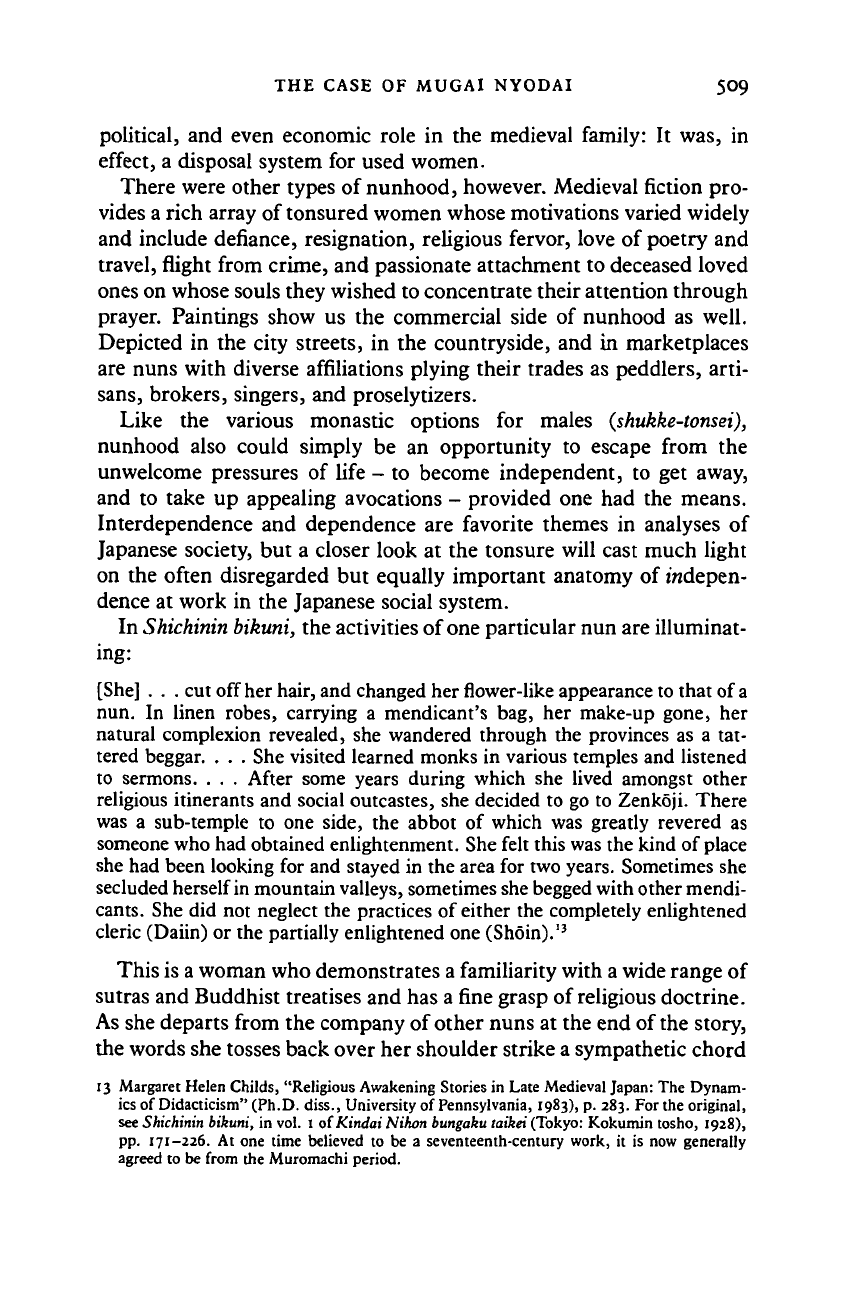
THE CASE OF MUGAI NYODAI 509
political, and even economic role in the medieval family: It was, in
effect, a disposal system for used women.
There were other types of nunhood, however. Medieval fiction pro-
vides a rich array of tonsured women whose motivations varied widely
and include defiance, resignation, religious fervor, love of poetry and
travel, flight from crime, and passionate attachment to deceased loved
ones on whose souls they wished to concentrate their attention through
prayer. Paintings show us the commercial side of nunhood as well.
Depicted in the city streets, in the countryside, and in marketplaces
are nuns with diverse affiliations plying their trades as peddlers, arti-
sans,
brokers, singers, and proselytizers.
Like the various monastic options for males (shukke-tonsei),
nunhood also could simply be an opportunity to escape from the
unwelcome pressures of life - to become independent, to get away,
and to take up appealing avocations - provided one had the means.
Interdependence and dependence are favorite themes in analyses of
Japanese society, but a closer look at the tonsure will cast much light
on the often disregarded but equally important anatomy of indepen-
dence at work in the Japanese social system.
In Shichinin bikuni, the activities of one particular nun are illuminat-
ing:
[She] . . . cut off her hair, and changed her flower-like appearance to that of
a
nun. In linen robes, carrying a mendicant's bag, her make-up gone, her
natural complexion revealed, she wandered through the provinces as a tat-
tered beggar. . . . She visited learned monks in various temples and listened
to sermons. . . . After some years during which she lived amongst other
religious itinerants and social outcastes, she decided to go to Zenkoji. There
was a sub-temple to one side, the abbot of which was greatly revered as
someone who had obtained enlightenment. She felt this was the kind of place
she had been looking for and stayed in the area for two years. Sometimes she
secluded herself in mountain valleys, sometimes she begged with other mendi-
cants.
She did not neglect the practices of either the completely enlightened
cleric (Daiin) or the partially enlightened one (Shoin).'
3
This is a woman who demonstrates a familiarity with a wide range of
sutras and Buddhist treatises and has a fine grasp of religious doctrine.
As she departs from the company of other nuns at the end of the story,
the words she tosses back over her shoulder strike a sympathetic chord
13 Margaret Helen Childs, "Religious Awakening Stories in Late Medieval Japan: The Dynam-
ics of Didacticism" (Ph.D. diss., University of Pennsylvania, 1983), p. 283. For the original,
see
Shichinin
bikuni, in vol. 1 oiKindai Nikon
bungaku
taikei
(Tokyo:
Kokumin tosho, 1928),
pp.
171-226. At one time believed to be a seventeenth-century work, it is now generally
agreed to be from the Muromachi period.
Cambridge Histories Online © Cambridge University Press, 2008
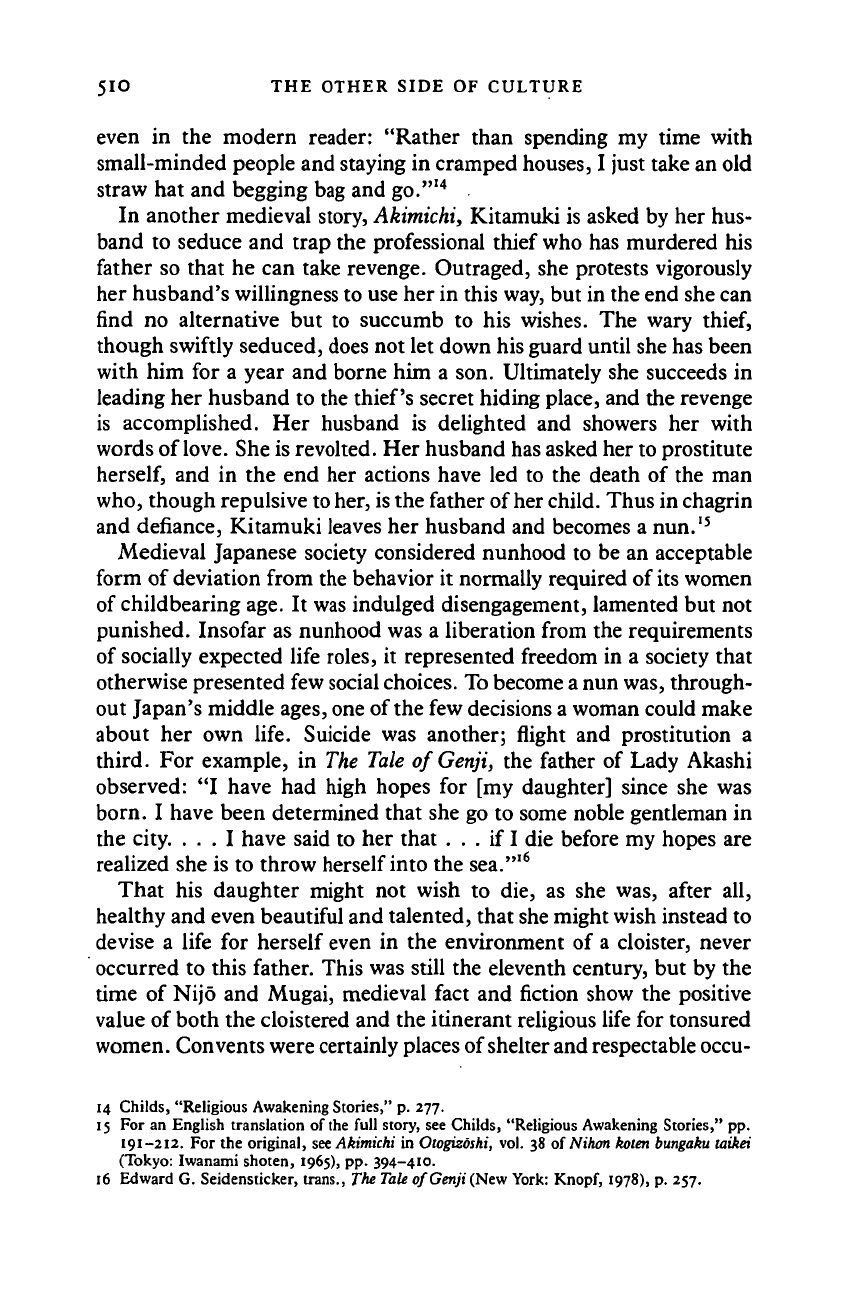
5IO THE OTHER SIDE OF CULTURE
even in the modern reader: "Rather than spending my time with
small-minded people and staying in cramped houses, I just take an old
straw hat and begging bag and go.'"
4
In another medieval story, Akimichi, Kitamuki is asked by her hus-
band to seduce and trap the professional thief who has murdered his
father so that he can take revenge. Outraged, she protests vigorously
her husband's willingness to use her in this way, but in the end she can
find no alternative but to succumb to his wishes. The wary
thief,
though swiftly seduced, does not let down his guard until she has been
with him for a year and borne him a son. Ultimately she succeeds in
leading her husband to the thief's secret hiding place, and the revenge
is accomplished. Her husband is delighted and showers her with
words of
love.
She is revolted. Her husband has asked her to prostitute
herself,
and in the end her actions have led to the death of the man
who,
though repulsive to her, is the father of her child. Thus in chagrin
and defiance, Kitamuki leaves her husband and becomes a nun.
15
Medieval Japanese society considered nunhood to be an acceptable
form of deviation from the behavior it normally required of its women
of childbearing age. It was indulged disengagement, lamented but not
punished. Insofar as nunhood was a liberation from the requirements
of socially expected life roles, it represented freedom in a society that
otherwise presented few social
choices.
To become
a
nun
was,
through-
out Japan's middle ages, one of the few decisions a woman could make
about her own life. Suicide was another; flight and prostitution a
third. For example, in The
Tale
of
Genji,
the father of Lady Akashi
observed: "I have had high hopes for [my daughter] since she was
born. I have been determined that she go to some noble gentleman in
the city. ... I have said to her that ... if I die before my hopes are
realized she is to throw herself into the sea.'"
6
That his daughter might not wish to die, as she was, after all,
healthy and even beautiful and talented, that she might wish instead to
devise a life for herself even in the environment of a cloister, never
occurred to this father. This was still the eleventh century, but by the
time of Nijo and Mugai, medieval fact and fiction show the positive
value of both the cloistered and the itinerant religious life for tonsured
women. Convents were certainly places of shelter and respectable occu-
14 Childs, "Religious Awakening Stories," p. 277.
15 For an English translation of the full story, see Childs, "Religious Awakening Stories," pp.
191-212.
For the original, see Akimichi in Otogizoshi, vol. 38 of Nihon koien
bungaku
laikei
(Tokyo: Iwanami shoten, 1965), pp. 394-410.
16 Edward G. Seidensticker, trans., The
Tale
of Genji (New York:
Knopf,
1978), p. 257.
Cambridge Histories Online © Cambridge University Press, 2008
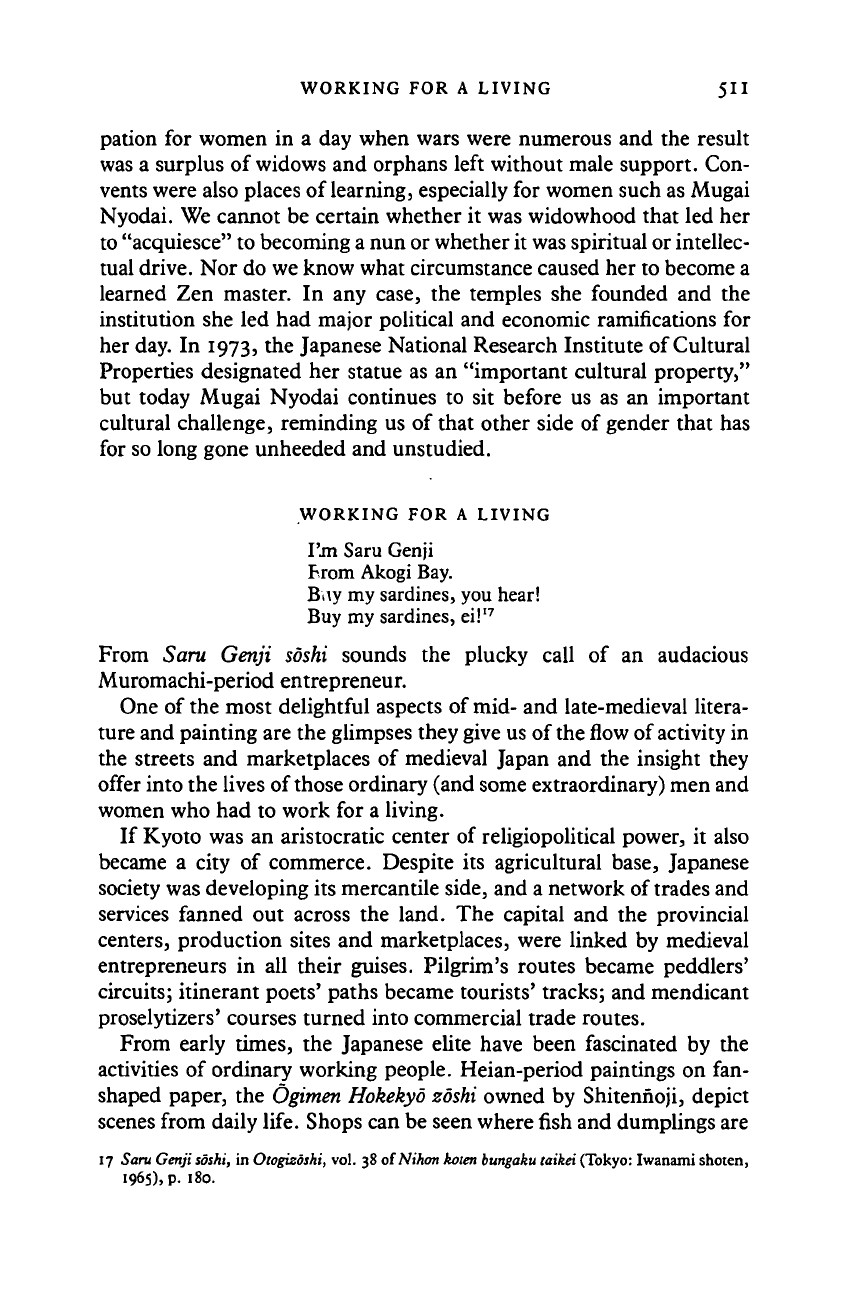
WORKING FOR A LIVING 511
pation
for
women
in a day
when wars were numerous
and the
result
was
a
surplus
of
widows
and
orphans left without male support.
Con-
vents were also places
of
learning, especially
for
women such as Mugai
Nyodai. We cannot
be
certain whether
it
was widowhood that
led her
to "acquiesce" to becoming a nun or whether
it
was spiritual or intellec-
tual drive. Nor
do
we know what circumstance caused
her
to become
a
learned
Zen
master.
In any
case,
the
temples
she
founded
and the
institution
she led had
major political
and
economic ramifications
for
her day.
In
1973,
the
Japanese National Research Institute
of
Cultural
Properties designated
her
statue
as an
"important cultural property,"
but today Mugai Nyodai continues
to sit
before
us as an
important
cultural challenge, reminding
us of
that other side
of
gender that
has
for
so
long gone unheeded
and
unstudied.
WORKING FOR A LIVING
I'm Saru Genji
From Akogi Bay.
Buy my sardines, you hear!
Buy my sardines, ei!
17
From Saru Genji soshi sounds
the
plucky call
of an
audacious
Muromachi-period entrepreneur.
One
of
the most delightful aspects
of
mid-
and
late-medieval litera-
ture and painting are the glimpses they give us
of
the flow of activity
in
the streets
and
marketplaces
of
medieval Japan
and the
insight they
offer into the lives
of
those ordinary (and some extraordinary) men and
women who
had to
work
for a
living.
If Kyoto
was an
aristocratic center
of
religiopolitical power,
it
also
became
a
city
of
commerce. Despite
its
agricultural base, Japanese
society was developing its mercantile side, and
a
network
of
trades and
services fanned
out
across
the
land.
The
capital
and the
provincial
centers, production sites
and
marketplaces, were linked
by
medieval
entrepreneurs
in all
their guises. Pilgrim's routes became peddlers'
circuits; itinerant poets' paths became tourists' tracks;
and
mendicant
proselytizers' courses turned into commercial trade routes.
From early times,
the
Japanese elite have been fascinated
by the
activities
of
ordinary working people. Heian-period paintings
on fan-
shaped paper,
the
Ogimen Hokekyo zoshi owned
by
Shitennoji, depict
scenes from daily life. Shops can
be
seen where fish and dumplings are
17 Saru Genji
soshi,
in
Otogizoshi, vol. 38 otNihon koten bungaku taikei (Tokyo: Iwanami shoten,
1965),
p. 180.
Cambridge Histories Online © Cambridge University Press, 2008
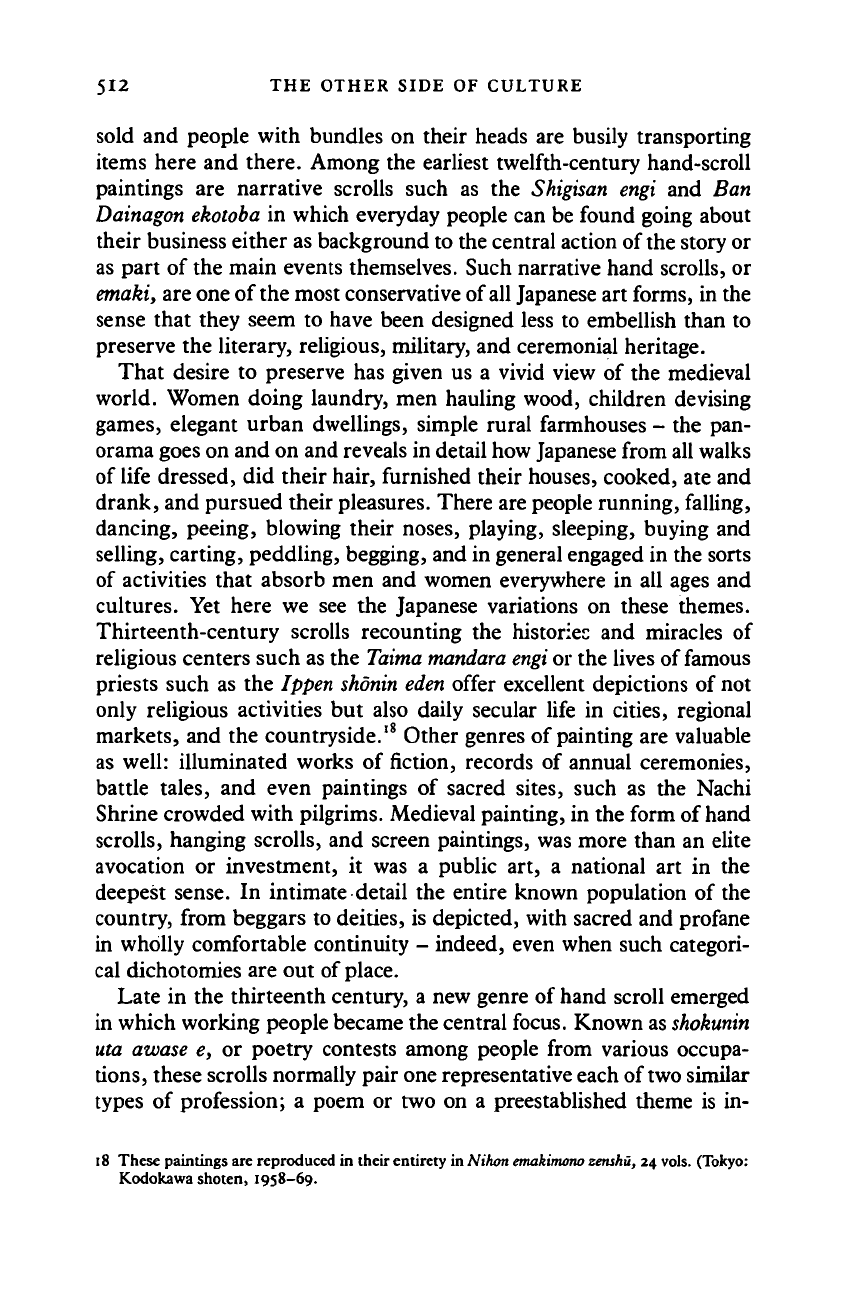
512 THE OTHER SIDE OF CULTURE
sold and people with bundles on their heads are busily transporting
items here and there. Among the earliest twelfth-century hand-scroll
paintings are narrative scrolls such as the Shigisan engi and Ban
Dainagon ekotoba
in which everyday people can be found going about
their business either as background to the central action of the story or
as part of the main events themselves. Such narrative hand scrolls, or
emaki,
are one of the most conservative of all Japanese art forms, in the
sense that they seem to have been designed less to embellish than to
preserve the literary, religious, military, and ceremonial heritage.
That desire to preserve has given us a vivid view of the medieval
world. Women doing laundry, men hauling wood, children devising
games, elegant urban dwellings, simple rural farmhouses - the pan-
orama goes on and on and reveals in detail how Japanese from all walks
of life dressed, did their hair, furnished their houses, cooked, ate and
drank, and pursued their pleasures. There are people running, falling,
dancing, peeing, blowing their noses, playing, sleeping, buying and
selling, carting, peddling, begging, and in general engaged in the sorts
of activities that absorb men and women everywhere in all ages and
cultures. Yet here we see the Japanese variations on these themes.
Thirteenth-century scrolls recounting the histories and miracles of
religious centers such as the
Taima mandara engi
or the lives of famous
priests such as the Ippen
shonin eden
offer excellent depictions of not
only religious activities but also daily secular life in cities, regional
markets, and the countryside.
18
Other genres of painting are valuable
as well: illuminated works of fiction, records of annual ceremonies,
battle tales, and even paintings of sacred sites, such as the Nachi
Shrine crowded with pilgrims. Medieval painting, in the form of hand
scrolls, hanging scrolls, and screen paintings, was more than an elite
avocation or investment, it was a public art, a national art in the
deepest sense. In intimate detail the entire known population of the
country, from beggars to deities, is depicted, with sacred and profane
in wholly comfortable continuity - indeed, even when such categori-
cal dichotomies are out of place.
Late in the thirteenth century, a new genre of hand scroll emerged
in which working people became the central focus. Known as
shokunin
uta awase e, or poetry contests among people from various occupa-
tions,
these scrolls normally pair one representative each of two similar
types of profession; a poem or two on a preestablished theme is in-
18 These paintings are reproduced in their entirety in
Nihon emakimono
zenshu,
24
vols.
(Tokyo:
Kodokawa shoten, 1938-69.
Cambridge Histories Online © Cambridge University Press, 2008
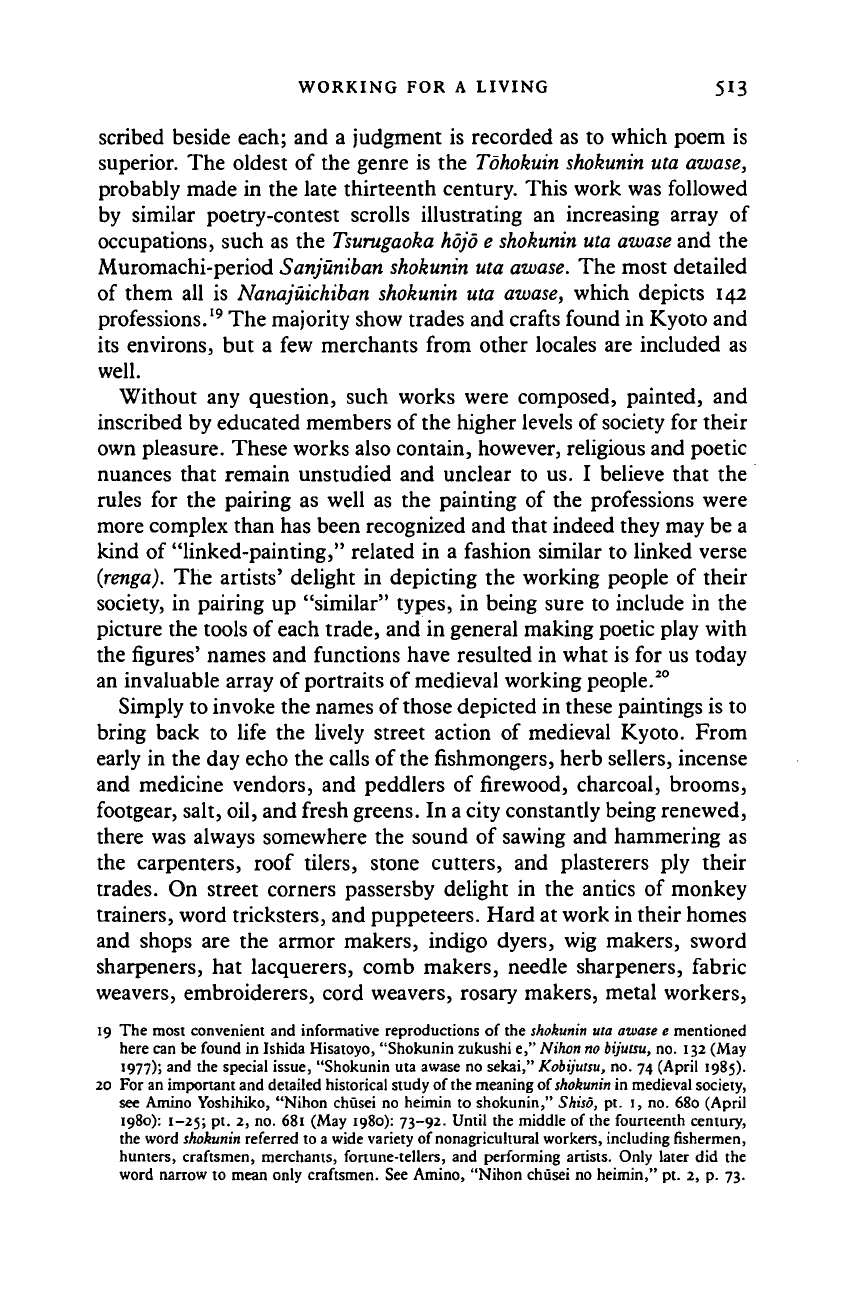
WORKING FOR A LIVING 513
scribed beside each; and a judgment is recorded as to which poem is
superior. The oldest of the genre is the Tdhokuin shokunin uta awase,
probably made in the late thirteenth century. This work was followed
by similar poetry-contest scrolls illustrating an increasing array of
occupations, such as the Tsurugaoka hojo e shokunin uta awase and the
Muromachi-period Sanjuniban shokunin uta awase. The most detailed
of them all is Nanajuichiban shokunin uta awase, which depicts 142
professions.
19
The majority show trades and crafts found in Kyoto and
its environs, but a few merchants from other locales are included as
well.
Without any question, such works were composed, painted, and
inscribed by educated members of the higher levels of society for their
own pleasure. These works also contain, however, religious and poetic
nuances that remain unstudied and unclear to us. I believe that the
rules for the pairing as well as the painting of the professions were
more complex than has been recognized and that indeed they may be a
kind of "linked-painting," related in a fashion similar to linked verse
(renga).
The artists' delight in depicting the working people of their
society, in pairing up "similar" types, in being sure to include in the
picture the tools of each trade, and in general making poetic play with
the figures' names and functions have resulted in what is for us today
an invaluable array of portraits of medieval working people.
20
Simply to invoke the names of those depicted in these paintings is to
bring back to life the lively street action of medieval Kyoto. From
early in the day echo the calls of the fishmongers, herb sellers, incense
and medicine vendors, and peddlers of firewood, charcoal, brooms,
footgear, salt, oil, and fresh greens. In a city constantly being renewed,
there was always somewhere the sound of sawing and hammering as
the carpenters, roof tilers, stone cutters, and plasterers ply their
trades. On street corners passersby delight in the antics of monkey
trainers, word tricksters, and puppeteers. Hard at work in their homes
and shops are the armor makers, indigo dyers, wig makers, sword
sharpeners, hat lacquerers, comb makers, needle sharpeners, fabric
weavers, embroiderers, cord weavers, rosary makers, metal workers,
19 The most convenient and informative reproductions of the
shokunin
uta awase e mentioned
here can be found in Ishida Hisatoyo, "Shokunin zukushi e," Nihon
no
bijutsu,
no. 132 (May
I977)> and the special issue, "Shokunin uta awase no sekai," Kobijutsu, no. 74 (April 1985).
20 For an important and detailed historical study of the meaning of
shokunin
in medieval society,
see Amino Yoshihiko, "Nihon chusei no heimin to shokunin," Shiso, pt. 1, no. 680 (April
1980):
1-25; pt. 2, no. 681 (May 1980): 73-92. Until the middle of the fourteenth century,
the word
shokunin
referred to a wide variety of nonagricultural workers, including fishermen,
hunters, craftsmen, merchants, fortune-tellers, and performing artists. Only later did the
word narrow to mean only craftsmen. See Amino, "Nihon chusei no heimin," pt. 2, p. 73.
Cambridge Histories Online © Cambridge University Press, 2008
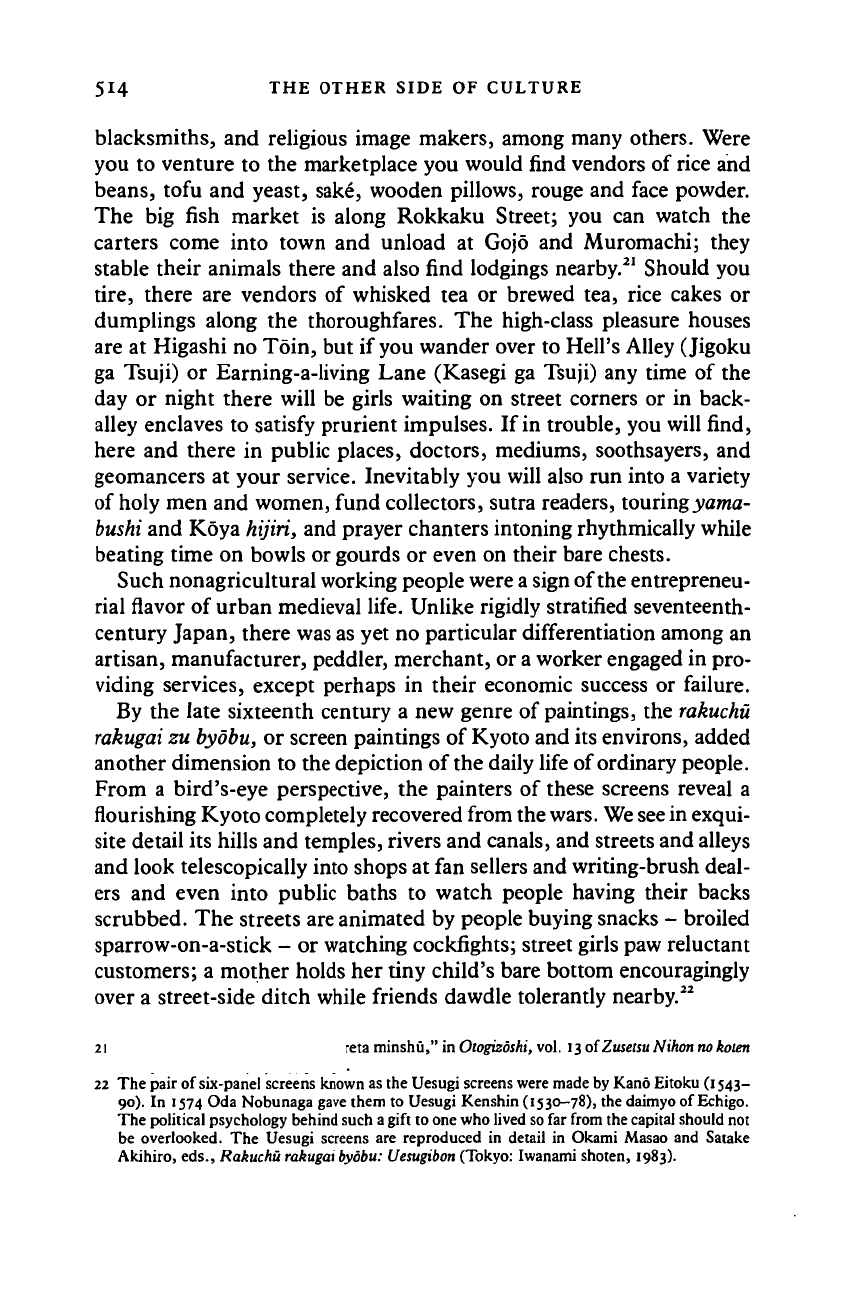
514 THE OTHER SIDE OF CULTURE
blacksmiths, and religious image makers, among many others. Were
you to venture to the marketplace you would find vendors of rice and
beans,
tofu and yeast, sake, wooden pillows, rouge and face powder.
The big fish market is along Rokkaku Street; you can watch the
carters come into town and unload at Gojo and Muromachi; they
stable their animals there and also find lodgings nearby.
21
Should you
tire,
there are vendors of whisked tea or brewed tea, rice cakes or
dumplings along the thoroughfares. The high-class pleasure houses
are at Higashi no Toin, but if you wander over to Hell's Alley (Jigoku
ga Tsuji) or Earning-a-living Lane (Kasegi ga Tsuji) any time of the
day or night there will be girls waiting on street corners or in back-
alley enclaves to satisfy prurient impulses. If
in
trouble, you will find,
here and there in public places, doctors, mediums, soothsayers, and
geomancers at your service. Inevitably you will also run into a variety
of holy men and women, fund collectors, sutra readers, touringyama-
bushi
and Koya
hijiri,
and prayer chanters intoning rhythmically while
beating time on bowls or gourds or even on their bare chests.
Such nonagricultural working people were
a
sign of the entrepreneu-
rial flavor of urban medieval life. Unlike rigidly stratified seventeenth-
century Japan, there was as yet no particular differentiation among an
artisan, manufacturer, peddler, merchant, or a worker engaged in pro-
viding services, except perhaps in their economic success or failure.
By the late sixteenth century a new genre of
paintings,
the
rakuchu
rakugai
zu
bydbu,
or screen paintings of Kyoto and its environs, added
another dimension to the depiction of the daily life of ordinary people.
From a bird's-eye perspective, the painters of these screens reveal a
nourishing Kyoto completely recovered from the
wars.
We see
in exqui-
site detail its hills and temples, rivers and canals, and streets and alleys
and look telescopically into shops at fan sellers and writing-brush deal-
ers and even into public baths to watch people having their backs
scrubbed. The streets are animated by people buying snacks - broiled
sparrow-on-a-stick - or watching cockfights; street girls paw reluctant
customers; a mother holds her tiny child's bare bottom encouragingly
over a street-side ditch while friends dawdle tolerantly nearby.
22
21 Toyoda Takeshi, "Otogi ni arawareta minshu," in Otogizoshi, vol. 13 of ZusetsuNihon
no
koten
(Tokyo, Shuseisha, 1980), p. 132.
22 The pair of six-panel screens known as the Uesugi screens were made by Kano Eitoku
(1543-
90).
In 1574 Oda Nobunaga gave them to Uesugi Kenshin (1530-78), the daimyo of Echigo.
The political psychology behind such a gift to one who lived so far from the capital should not
be overlooked. The Uesugi screens are reproduced in detail in Okami Masao and Satake
Akihiro, eds., Rakuchu rakugai bydbu: Uesugibon (Tokyo: Iwanami shoten, 1983).
Cambridge Histories Online © Cambridge University Press, 2008
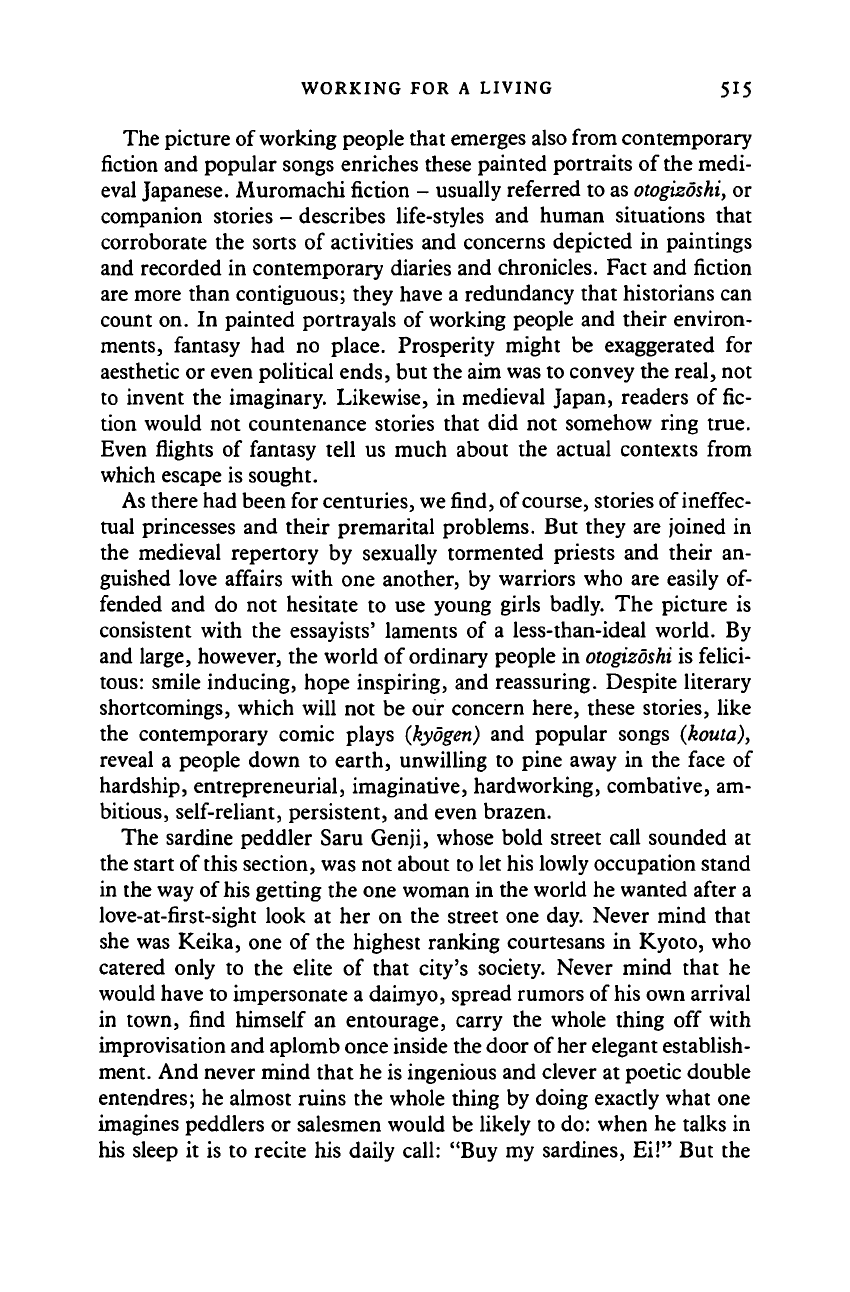
WORKING FOR A LIVING 515
The picture of working people that emerges also from contemporary
fiction and popular songs enriches these painted portraits of the medi-
eval Japanese. Muromachi fiction - usually referred to as
otogizoshi,
or
companion stories - describes life-styles and human situations that
corroborate the sorts of activities and concerns depicted in paintings
and recorded in contemporary diaries and chronicles. Fact and fiction
are more than contiguous; they have a redundancy that historians can
count on. In painted portrayals of working people and their environ-
ments, fantasy had no place. Prosperity might be exaggerated for
aesthetic or even political ends, but the aim was to convey the real, not
to invent the imaginary. Likewise, in medieval Japan, readers of fic-
tion would not countenance stories that did not somehow ring true.
Even flights of fantasy tell us much about the actual contexts from
which escape is sought.
As there had been for centuries, we find, of course, stories of ineffec-
tual princesses and their premarital problems. But they are joined in
the medieval repertory by sexually tormented priests and their an-
guished love affairs with one another, by warriors who are easily of-
fended and do not hesitate to use young girls badly. The picture is
consistent with the essayists' laments of a less-than-ideal world. By
and large, however, the world of ordinary people in
otogizoshi
is felici-
tous:
smile inducing, hope inspiring, and reassuring. Despite literary
shortcomings, which will not be our concern here, these stories, like
the contemporary comic plays (kyogen) and popular songs (Jtouta),
reveal a people down to earth, unwilling to pine away in the face of
hardship, entrepreneurial, imaginative, hardworking, combative, am-
bitious, self-reliant, persistent, and even brazen.
The sardine peddler Saru Genji, whose bold street call sounded at
the start of this section, was not about to let his lowly occupation stand
in the way of his getting the one woman in the world he wanted after a
love-at-first-sight look at her on the street one day. Never mind that
she was Keika, one of the highest ranking courtesans in Kyoto, who
catered only to the elite of that city's society. Never mind that he
would have to impersonate a daimyo, spread rumors of his own arrival
in town, find himself an entourage, carry the whole thing off with
improvisation and aplomb once inside the door of her elegant establish-
ment. And never mind that he is ingenious and clever at poetic double
entendres; he almost ruins the whole thing by doing exactly what one
imagines peddlers or salesmen would be likely to do: when he talks in
his sleep it is to recite his daily call: "Buy my sardines, Ei!" But the
Cambridge Histories Online © Cambridge University Press, 2008
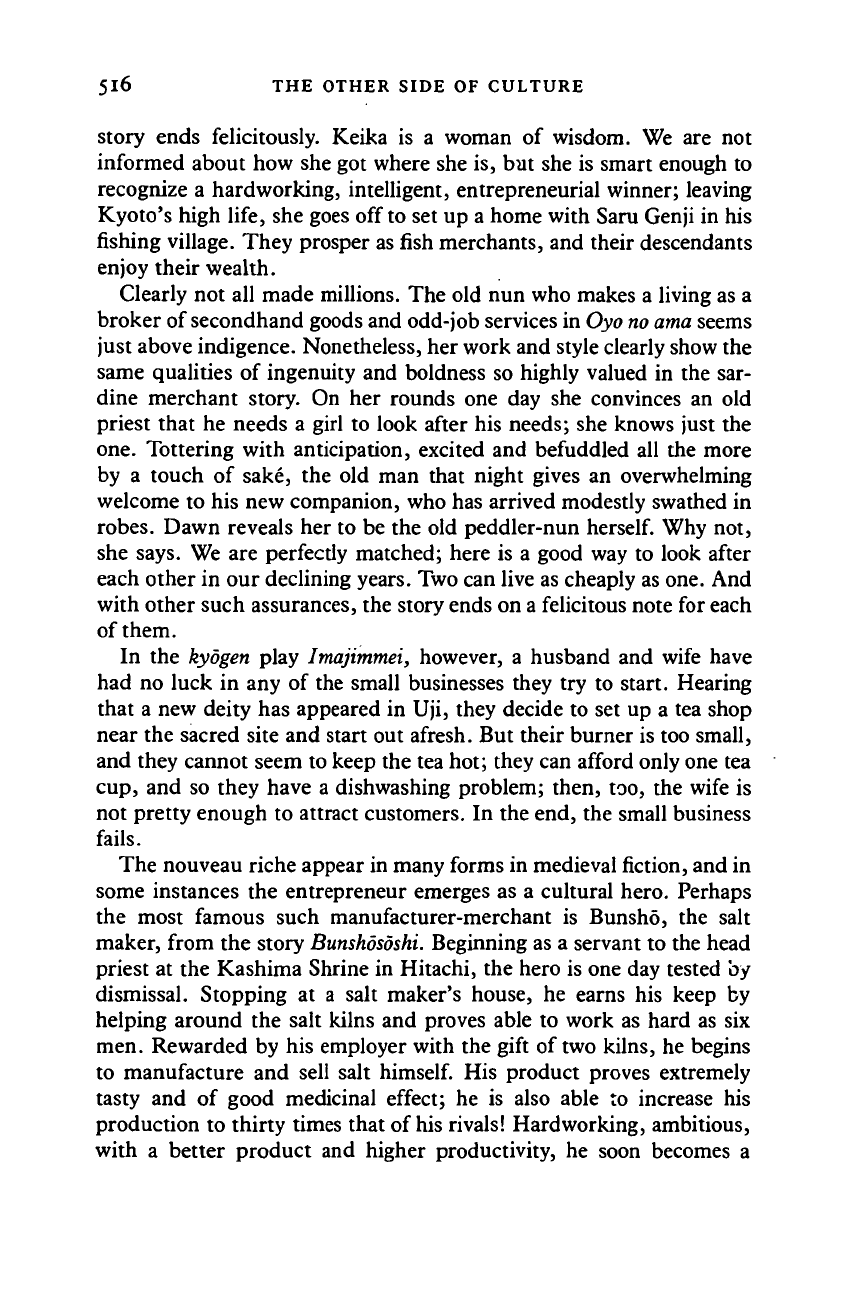
5l6 THE OTHER SIDE OF CULTURE
story ends felicitously. Keika
is a
woman
of
wisdom.
We are not
informed about how she got where she is,
bat
she
is
smart enough
to
recognize
a
hardworking, intelligent, entrepreneurial winner; leaving
Kyoto's high life, she goes
off
to set up
a
home with Sam Genji
in his
fishing village. They prosper as fish merchants, and their descendants
enjoy their wealth.
Clearly
not all
made millions. The old nun who makes
a
living as
a
broker of secondhand goods and odd-job services in
Oyo no ama
seems
just above indigence. Nonetheless, her work and style clearly show the
same qualities
of
ingenuity
and
boldness
so
highly valued
in the sar-
dine merchant story.
On her
rounds
one day she
convinces
an old
priest that
he
needs
a
girl
to
look after
his
needs; she knows just
the
one.
Tottering with anticipation, excited
and
befuddled
all the
more
by
a
touch
of
sake,
the old man
that night gives
an
overwhelming
welcome
to
his new companion, who has arrived modestly swathed
in
robes.
Dawn reveals
her to be the old
peddler-nun
herself.
Why
not,
she says. We
are
perfectly matched; here
is a
good way
to
look after
each other in our declining years. Two can live as cheaply as one. And
with other such assurances, the story ends on a felicitous note for each
of them.
In
the
kyogen play
Imajimmei,
however,
a
husband
and
wife have
had
no
luck
in any of
the small businesses they
try to
start. Hearing
that
a
new deity has appeared
in Uji,
they decide
to set up a tea
shop
near the sacred site and start out afresh. But their burner is too small,
and they cannot seem to keep the tea hot; they can afford only one tea
cup,
and so
they have
a
dishwashing problem; then, too,
the
wife
is
not pretty enough
to
attract customers.
In
the end, the small business
fails.
The nouveau riche appear in many forms
in
medieval fiction, and in
some instances
the
entrepreneur emerges
as a
cultural hero. Perhaps
the most famous such manufacturer-merchant
is
Bunsho,
the
salt
maker, from the story
Bunshososhi.
Beginning as
a
servant
to
the head
priest
at the
Kashima Shrine
in
Hitachi, the hero
is
one day tested
by
dismissal. Stopping
at a
salt maker's house,
he
earns
his
keep
by
helping around
the
salt kilns
and
proves able
to
work
as
hard
as six
men. Rewarded
by
his employer with the gift
of
two kilns,
he
begins
to manufacture
and
sell salt
himself.
His
product proves extremely
tasty
and of
good medicinal effect;
he is
also able
to
increase
his
production
to
thirty times that
of
his rivals! Hardworking, ambitious,
with
a
better product
and
higher productivity,
he
soon becomes
a
Cambridge Histories Online © Cambridge University Press, 2008
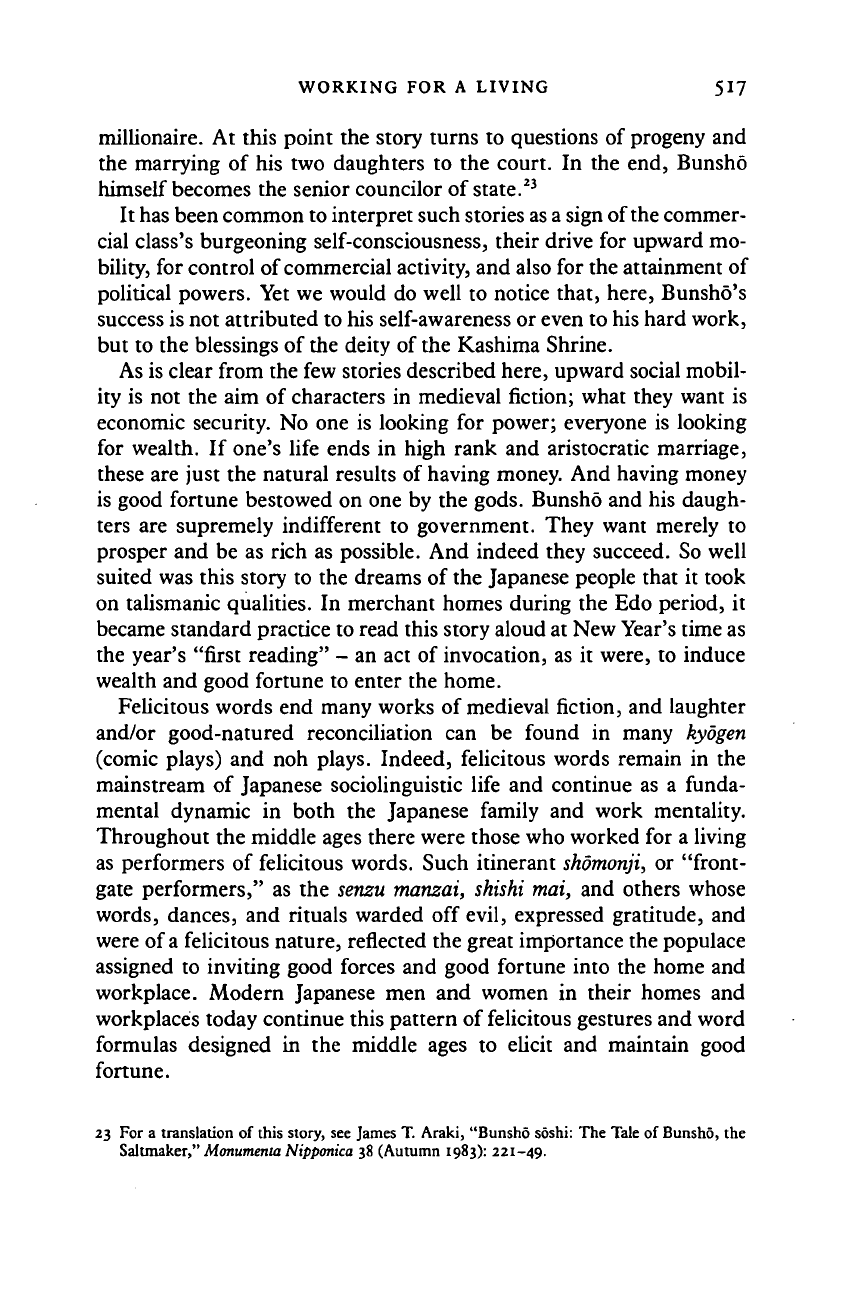
WORKING FOR A LIVING 517
millionaire. At this point the story turns to questions of progeny and
the marrying of his two daughters to the court. In the end, Bunsho
himself becomes the senior councilor of state.
23
It has been common to interpret such stories as a sign of the commer-
cial class's burgeoning self-consciousness, their drive for upward mo-
bility, for control of commercial activity, and also for the attainment of
political powers. Yet we would do well to notice that, here, Bunsho's
success is not attributed to his self-awareness or even to his hard work,
but to the blessings of the deity of the Kashima Shrine.
As is clear from the few stories described here, upward social mobil-
ity is not the aim of characters in medieval fiction; what they want is
economic security. No one is looking for power; everyone is looking
for wealth. If one's life ends in high rank and aristocratic marriage,
these are just the natural results of having money. And having money
is good fortune bestowed on one by the gods. Bunsho and his daugh-
ters are supremely indifferent to government. They want merely to
prosper and be as rich as possible. And indeed they succeed. So well
suited was this story to the dreams of the Japanese people that it took
on talismanic qualities. In merchant homes during the Edo period, it
became standard practice to read this story aloud at New Year's time as
the year's "first reading" - an act of invocation, as it were, to induce
wealth and good fortune to enter the home.
Felicitous words end many works of medieval fiction, and laughter
and/or good-natured reconciliation can be found in many kyogen
(comic plays) and noh plays. Indeed, felicitous words remain in the
mainstream of Japanese sociolinguistic life and continue as a funda-
mental dynamic in both the Japanese family and work mentality.
Throughout the middle ages there were those who worked for a living
as performers of felicitous words. Such itinerant shomonji, or "front-
gate performers," as the senzu manzai, shishi mai, and others whose
words, dances, and rituals warded off evil, expressed gratitude, and
were of
a
felicitous nature, reflected the great importance the populace
assigned to inviting good forces and good fortune into the home and
workplace. Modern Japanese men and women in their homes and
workplaces today continue this pattern of felicitous gestures and word
formulas designed in the middle ages to elicit and maintain good
fortune.
23 For a translation of this story, see James T. Araki, "Bunsho soshi: The Tale of Bunsho, the
Saltmaker," Monumenia Nipponica 38 (Autumn 1983): 221-49.
Cambridge Histories Online © Cambridge University Press, 2008
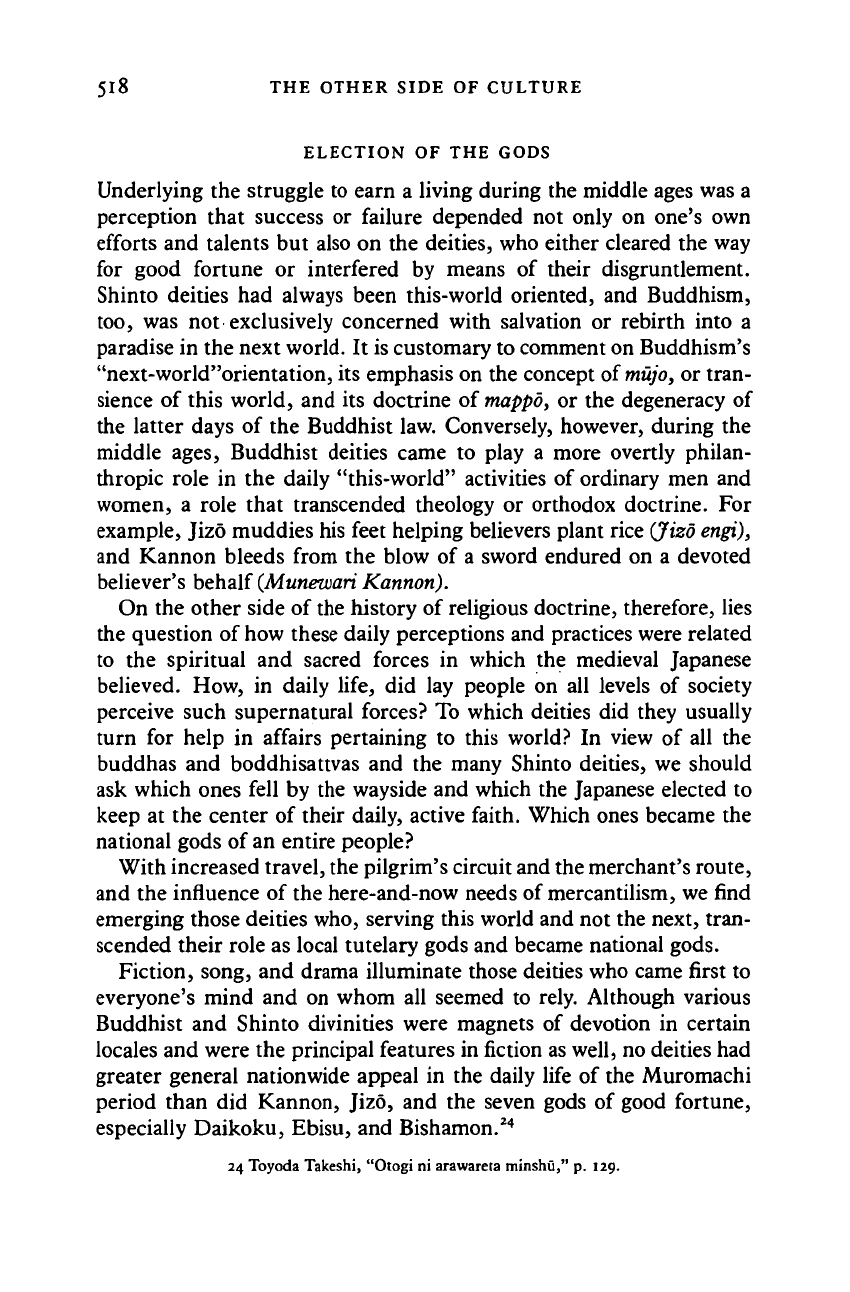
5l8 THE OTHER SIDE OF CULTURE
ELECTION OF THE GODS
Underlying the struggle to earn a living during the middle ages was a
perception that success or failure depended not only on one's own
efforts and talents but also on the deities, who either cleared the way
for good fortune or interfered by means of their disgruntlement.
Shinto deities had always been this-world oriented, and Buddhism,
too,
was not exclusively concerned with salvation or rebirth into a
paradise in the next world. It is customary to comment on Buddhism's
"next-world"orientation, its emphasis on the concept of
mujo,
or tran-
sience of this world, and its doctrine of
mappo,
or the degeneracy of
the latter days of the Buddhist law. Conversely, however, during the
middle ages, Buddhist deities came to play a more overtly philan-
thropic role in the daily "this-world" activities of ordinary men and
women, a role that transcended theology or orthodox doctrine. For
example, Jizo muddies his feet helping believers plant rice (Jizo
engi),
and Kannon bleeds from the blow of a sword endured on a devoted
believer's behalf
(Munewari
Kannon).
On the other side of the history of religious doctrine, therefore, lies
the question of how these daily perceptions and practices were related
to the spiritual and sacred forces in which the medieval Japanese
believed. How, in daily life, did lay people on all levels of society
perceive such supernatural forces? To which deities did they usually
turn for help in affairs pertaining to this world? In view of all the
buddhas and boddhisattvas and the many Shinto deities, we should
ask which ones fell by the wayside and which the Japanese elected to
keep at the center of their daily, active faith. Which ones became the
national gods of an entire people?
With increased travel, the pilgrim's circuit and the merchant's route,
and the influence of the here-and-now needs of mercantilism, we find
emerging those deities who, serving this world and not the next, tran-
scended their role as local tutelary gods and became national gods.
Fiction, song, and drama illuminate those deities who came first to
everyone's mind and on whom all seemed to rely. Although various
Buddhist and Shinto divinities were magnets of devotion in certain
locales and were the principal features in fiction as well, no deities had
greater general nationwide appeal in the daily life of the Muromachi
period than did Kannon, Jizo, and the seven gods of good fortune,
especially Daikoku, Ebisu, and Bishamon.
24
24 Toyoda Takeshi, "Otogi ni arawareta minshu," p. 129.
Cambridge Histories Online © Cambridge University Press, 2008
